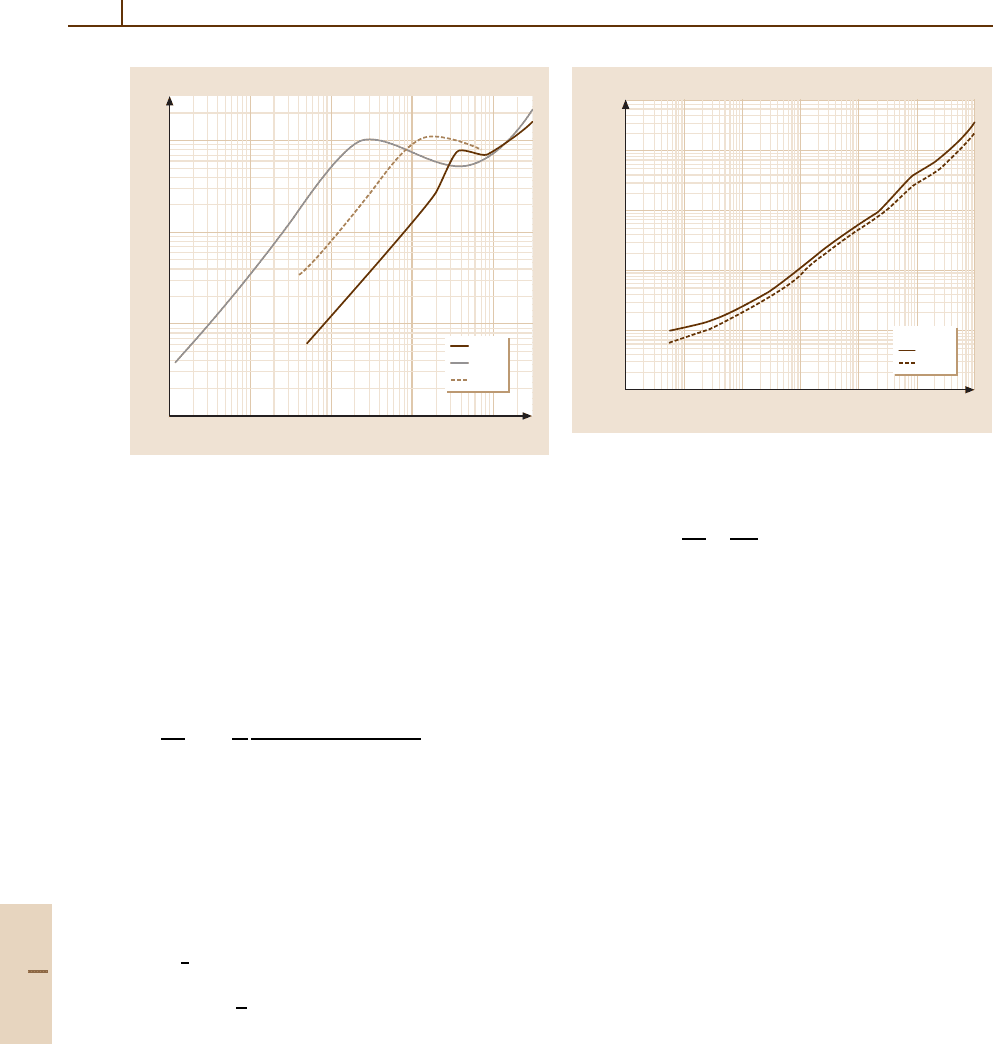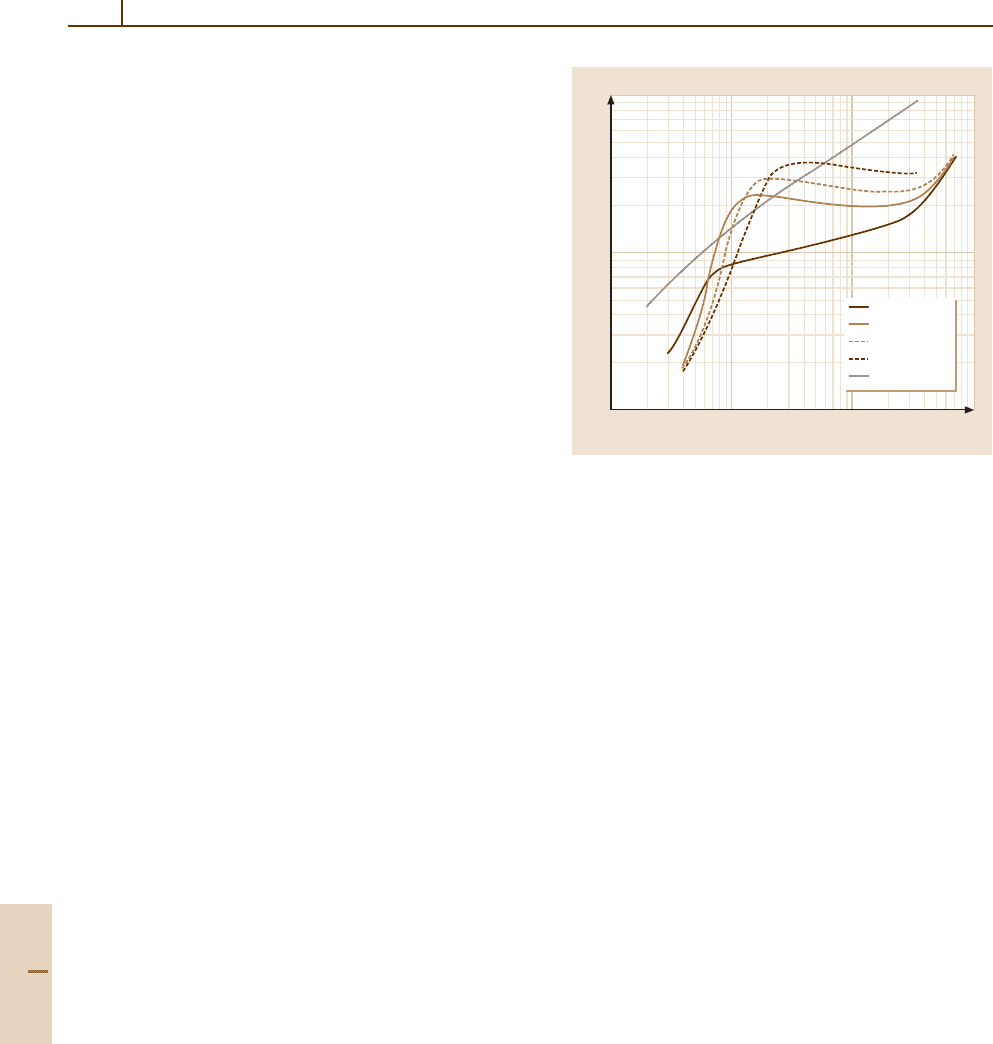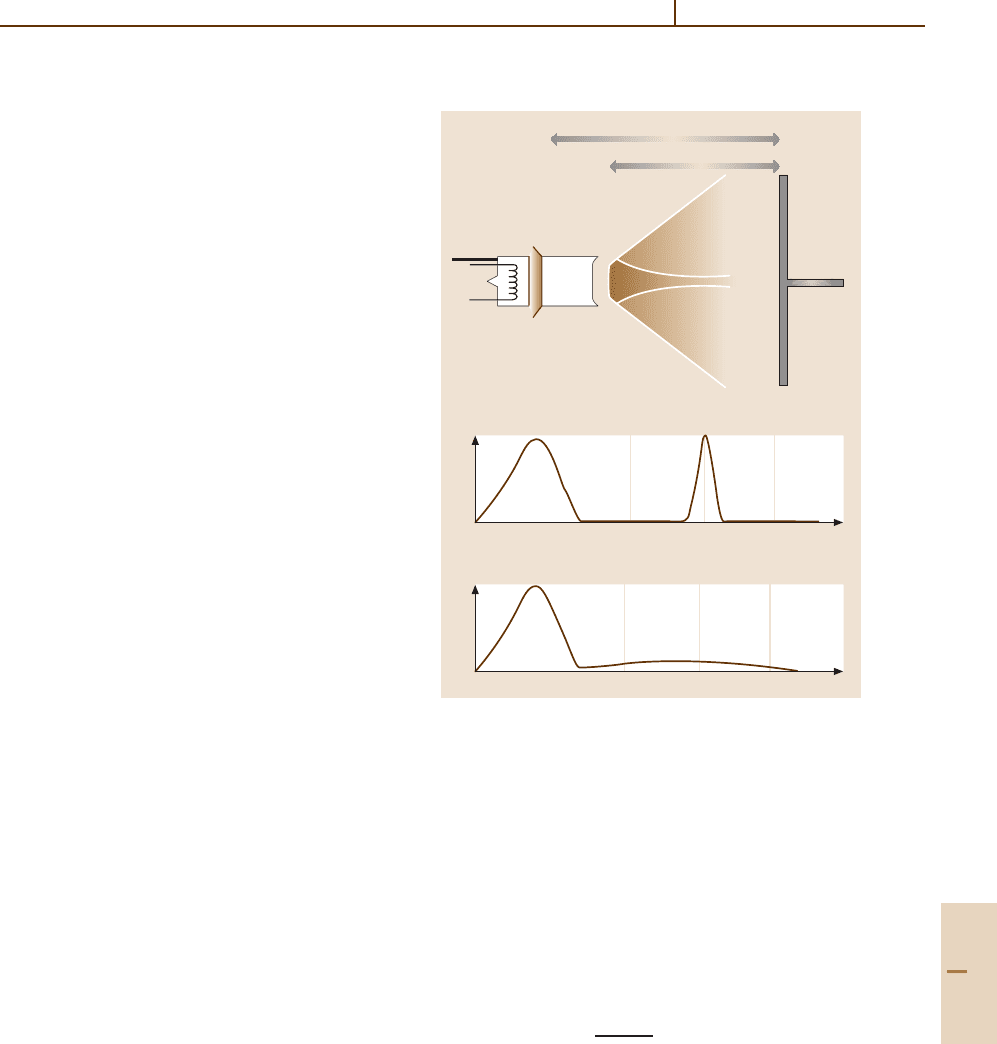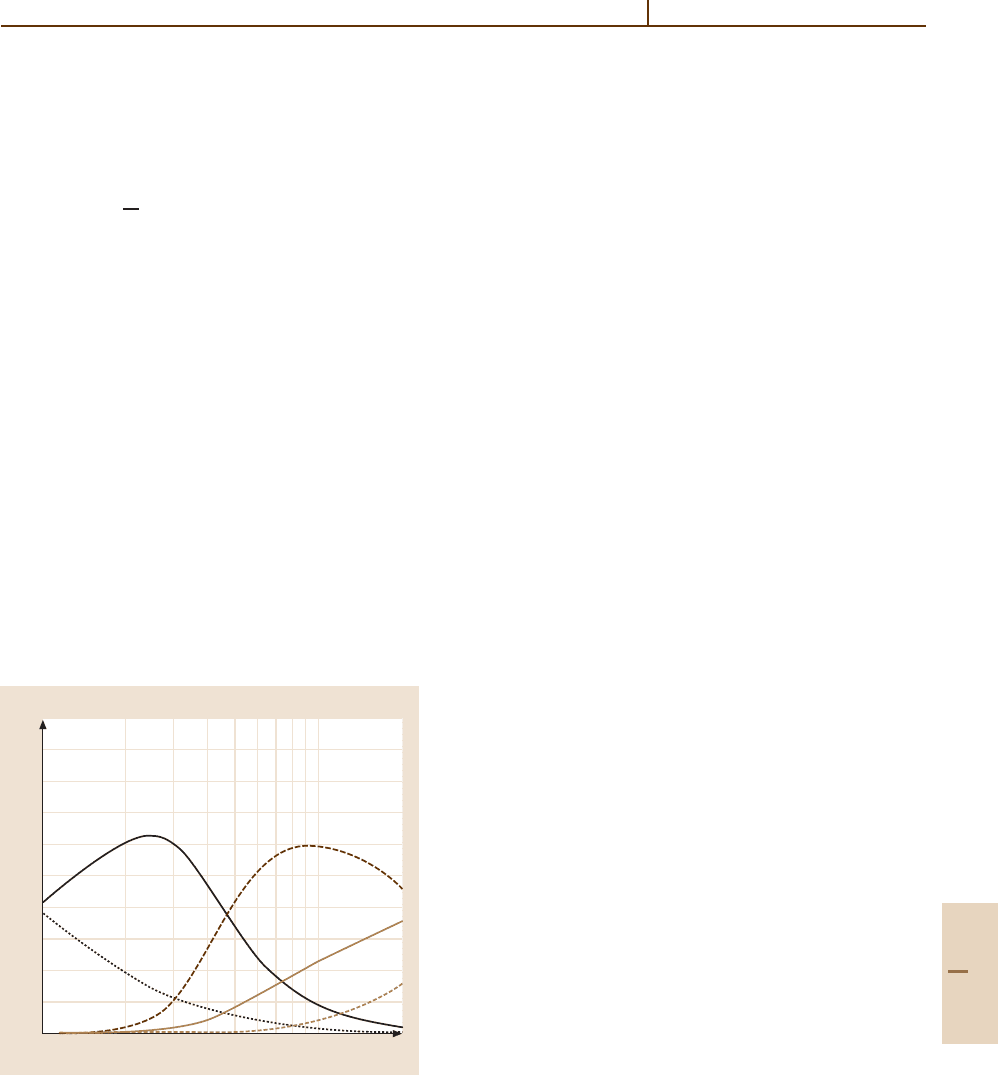Drake G.W.F. (editor) Handbook of Atomic, Molecular, and Optical Physics
Подождите немного. Документ загружается.


Conduction of Electricity in Gases 87.1 Electron Scattering and Transport Phenomena 1323
energy change, such as a variation of T
e
with position (as
in the theory of striations [87.18], but not on variations
due to pressure gradients which would affect ν
m
[87.8]).
Electron Free Diffusion
When the ionization density is low enough, the electrons
diffuse freely to the walls, being unaffected by the space
charge field caused by the heavier ions, which diffuse
more slowly than the electrons. Setting E =0in(87.13),
the electron current due to diffusion is
Γ
e
=−∇
r
(D
e
n
e
). (87.16)
Since the electron heating and elastic recoil terms in
(87.10) do not contribute to a net gain or loss of electrons,
integration of (87.10) over v gives
∂n
e
∂t
+∇
r
· Γ
e
=
∂n
e
∂t
−∇
2
r
(D
e
n
e
) = 0 , (87.17)
for a decaying electron density. This equation is identical
in form to the thermal conductivity equation, which can
be solved analytically for certain simple geometries. For
the case of a long cylindrical container of radius R,the
equation becomes
∂n
e
∂t
= D
e
1
r
∂
∂r
r
∂n
e
∂r
,
(87.18)
if D
0
is constant and n
e
depends only on r. The general
solution for n
e
satisfying n
e
(R, t) = 0is
n
e
=
m=0
b
m
exp
−
t
t
m
J
0
a
m
r
R
,
(87.19)
where t
m
=[D
e
(a
m
/R)
2
]
−1
,andJ
0
is the zeroth-order
Bessel function with roots J
0
(a
m
) = 0, a
m+1
> a
m
.The
b
m
are determined by the radial dependence of n
e
at
t = 0. (If the coaxial wall of radius r
0
< R confines the
plasma to an annular region r
0
< r < R, the general solu-
tion must also include the zeroth-order Bessel function
of the second kind, Y
0
, to satisfy the boundary con-
ditions). The time constants t
m
decrease rapidly with
increasing m so that for sufficiently long t, the density
distribution relaxes (e.g., after the microwave or static
excitation is switched off) to
n
e
≈ b
0
exp
−
t
t
0
J
0
a
0
r
R
.
(87.20)
This is called the fundamental diffusion mode. The
above treatment gives a good approximation to n
e
(r)
provided that λ
mfp
R.
When ν
m
is velocity-independent and f
0
is the
Maxwellian of temperature T
e
,(87.14) becomes
D
e
=
k
B
T
e
mν
m
. (87.21)
For the case where a magnetic field is applied to the
ionized gas, parallel to the cylinder axis so as to impede
the electron diffusion to the walls, the free-diffusion
coefficient in equation (87.18) is replaced by
D
eB
=
ν
m
v
2
f
0
v
3
ν
2
m
+w
2
B
4πv
2
dv =
ν
m
v
2
3
ν
2
m
+w
2
B
.
(87.22)
In this case, the electrons cannot diffuse to the walls
unless they make collisions that interrupt their spiraling
motion.
Electron DC Mobility in Static Fields
From (87.13), the electron particle current induced by an
electric field E is Γ
e
=−n
e
µ
e
E, and the electron drift
velocity is
w
d
=
Γ
e
n
e
=−µ
e
E . (87.23)
Measurement of w
d
by a time-of-flight measurement
can in principle, through the use of (87.14), provide
some information about ν
m
, provided that f
0
v
is known.
Since a static electric field may perturb considerably
the distribution function, and since n
e
is low in such
measurements, f
0
v
should be determined using (87.10)
after having eliminated f
1
using (87.11). In the case
where ν
m
is independent of v,(87.15) after integration
by parts, reduces to
µ
e
=
e
mν
m
f
0
v
4πv
2
dv =
e
mν
m
, (87.24)
which is independent of f
0
v
.
In general, w
d
exhibits a complex depen-
dence on E/N, as shown for some example gases
in Fig. 87.4 [87.19]. The high mobility of electrons in
methane is of technical interest because of potential
applications in plasma switches used for current inter-
ruption [87.20]. The local maximum of w
d
in methane
for E/N = 3 Td (1 Townsend = 10
−17
Vcm
2
) and its
decrease with further increase of E/N arise because
of the onset of inelastic collisions due to vibrational
excitation at an energy close to the energy of the RT min-
imum [87.21]. As shown in Fig. 87.4, the drift velocities
are generally in the range of 10
6
–10
7
cm/s.
A detailed summary of electron drift velocities meas-
ured in many pure gases and gas mixtures of technical
interest is given in [87.22, 23], and the techniques are
elaborated in [87.24, 25].
The classic article on the drift velocity of ions in
electric fields measured by a transit time technique is that
Part G 87.1

1324 Part G Applications
10
7
10
6
10
5
10
4
10
–19
10
–18
10
–17
10
–16
10
–15
w
d
(cm/s)
SiF
4
CH
4
SiH
4
E/N (Vcm
2
)
Fig. 87.4 Electron drift velocities in polyatomic gases
of Hornbeck [87.26]. He showed that in some instances
earlier workers had identified molecular ions as atomic
ions. Contemporary measurements often use the guided
ion beam (GIB) technique to measure such quantities
as the symmetric charge transfer cross sections [87.27].
A review of measurement data has been given [87.28].
The Ratio of D
e
/
µ
e
for Electrons
From (87.14)and(87.15),
D
e
µ
e
=−
m
e
∞
0
v
4
/ν
m
f
0
v
dv
∞
0
v
3
/ν
m
∂ f
0
v
/∂v dv
.
(87.25)
The above ratio of the free-diffusion coefficient to the
mobility is termed the characteristic energy and it is
a measure of the average electron energy in certain cases.
When f
0
v
is Maxwellian, then
D
e
/µ
e
= k
B
T
e
/e (87.26)
becomes a direct measure of the electron energy, in-
dependent of ν
m
. Since the average electron energy
u
av
=
3
2
k
B
T
e
,(87.26) becomes
D
e
/µ
e
=
2
3
u
av
/e . (87.27)
In this form it is known as the Einstein relation. Further-
more, if ν
m
is independent of velocity, (87.27) applies
regardless of the velocity distribution.
Val ue s o f D
e
/µ
e
can be determined from exper-
iments where a static electric field E
z
is applied to
electrons drifting under steady state conditions of diffu-
sion. If D
e
is taken to be independent of position, then
10
1
0.1
0.01
0.001
0.001 0.01 0.1 1 10 100 1000
E/N (Td)
(eV)
H
2
k
ε
ε
Fig. 87.5 Calculated u
av
and D
e
/µ
e
coefficients in H
2
the generalization of (87.17)is
∇
2
n
e
=−
µ
e
D
e
E
z
∂n
e
∂z
.
(87.28)
Solutions to this equation for n
e
were for many years
used to deduce D
e
/µ
e
from the measurements [87.29].
However, Wagner et al. [87.30] showed that there are two
effective diffusion coefficients D
L
and D
T
in the lon-
gitudinal and transverse directions with D
L
D
T
.For
H
2
,N
2
and He, D
L
≈ D
T
/2, while for Ar, D
L
≈ D
T
/8.
See [87.31,32] for a quantitative discussion. The differ-
ent coefficients arise because n
e
and w
d
are functions of
∂n
e
/∂z.
For H
2
, f
0
v
is fairly well approximated by
a Maxwellian distribution. A comparison of the average
and characteristic energies u
av
and D
e
/µ
e
calculated
from the Boltzmann transport equation for H
2
is shown
in Fig. 87.5.
Ambipolar Diffusion
In the case of electron free diffusion discussed above,
diffusion of the electrons (and ions) is unaffected by
space-charge fields caused by an imbalance of positive
and negative charges. When the charge density is high,
this no longer holds. The resulting electric field caused
by space-charge separation retards the electron diffusion
and enhances the positive ion motion. In the steady state
the flows of positive ions and of electrons are equal, i. e.,
Γ
e
= Γ
+
. For electrons in the absence of temperature
gradients,
Γ
e
=−D
e
∇n
e
−n
e
µ
e
E , (87.29)
Part G 87.1

Conduction of Electricity in Gases 87.1 Electron Scattering and Transport Phenomena 1325
where D
e
and µ
e
are given by (87.14)and(87.15)re-
spectively. The analogous equation for the positive ions
is
Γ
+
=−D
+
∇n
+
−n
+
µ
+
E . (87.30)
Eliminating E between the two equations and setting
n
e
≈ n
+
= n,andΓ
e
≈ Γ
+
= Γ gives
Γ =−
D
+
µ
e
+ D
e
µ
+
µ
e
+µ
+
∇n .
(87.31)
The quantity in parentheses is a diffusion coefficient that
is applicable both to the electrons and to the ions. Since
they are interacting, they diffuse together. This quantity
is termed the ambipolar diffusion coefficient:
D
a
=
D
+
µ
e
+ D
e
µ
+
µ
e
+µ
+
. (87.32)
Franklin, however, has proposed that the term ambipolar
flow is a more correct physical description [87.33]. In
the case where the electrons have a temperature T
e
and
the ions a temperature T
+
,
D
+
µ
+
=
k
B
T
+
e
,
D
e
µ
e
=
k
B
T
e
e
,
(87.33)
and since µ
e
µ
+
,
D
a
≈ D
+
1 +
T
e
T
+
.
(87.34)
If T
e
T
+
,thenD
a
≈ µ −k
B
T
e
/e, i. e., the ambipo-
lar diffusion is determined by the ion mobility and the
electron energy. Allis and Rose [87.34] have studied
the transition from free to ambipolar diffusion as the
electron density is increased.
For the case in which the electrons and ions are dif-
fusing together in the radial direction across a static B
z
,
and the electron–atom and ion collision rates may be as-
sumed to be independent of T
e
, the magneto-ambipolar
diffusion coefficient is given by
D
aB
=
D
a
1 +µ
+
µ
e
B
2
. (87.35)
References [87.35, 36] review theoretical and experi-
mental work on diffusion in a magnetic field.
Debye Shielding
Consider an ensemble of positive ions and electrons in
thermal equilibrium. Each ion repels other ions in its
neighborhood, but attracts electrons. The space charge
around each ion (assumed stationary) is e(n
+
−n
e
),
which by Poisson’s equation creates a potential φ satis-
fying
∇
2
φ =−
e
0
(n
+
−n
e
), (87.36)
where n
+
is the average ion density. For time indepen-
dent fields in the absence of collisions, (87.8) becomes
v · ∇
r
f +eE· ∇
v
f = v · ∇
r
f −e∇
r
φ · ∇
v
f = 0 .
(87.37)
Assuming a solution of the form
f = f
0
exp
−
eφ
k
B
T
e
,
(87.38)
where f
0
is Maxwellian, and using
f
0
d
3
v = n
e
gives
−
e
k
B
T
e
v · ∇
r
φ +e∇
r
φ ·
v
k
B
T
f ≡ 0 .
(87.39)
Hence,
f d
3
v = n
e
exp
−
eφ
k
B
T
e
.
(87.40)
Since the assembly is macroscopically neutral, n
e
= n
+
,
and
∇
2
φ =−
e
0
n
+
1 −exp
−
eφ
k
B
T
e
.
(87.41)
If eφ k
B
T
e
,then
∇
2
φ ≈
e
2
0
n
+
φ
k
B
T
e
. (87.42)
If spherical symmetry is assumed,
φ =
e
4π
0
r
exp
−
r
λ
D
,
(87.43)
where
λ
D
=
0
k
B
T
e
n
+
e
2
1/2
(87.44)
is the Debye shielding length for the Coulomb potential.
λ
D
arises from the screening effect of the electron cloud
Part G 87.1

1326 Part G Applications
about each ion. The dimensions of a plasma must be
much larger than λ
D
for the electrons to act collectively,
i. e., to undergo plasma oscillations.
87.1.6 Cross Sections
Derived from Swarm Data
The use of transport theory to unfold low energy electron
collision cross sections from experimentally measured
electron transport data was originally introduced by
Townsend [87.29]. Beginning with trial input values
for the cross sections as a function of energy, the elec-
tron transport coefficients are calculated and compared
with experiments (such as w
d
, D
e
,
k
, and ioniza-
tion/attachment coefficients, measured as a function of
E/N). The input cross sections are then adjusted in the
appropriate energy range, and the comparison procedure
is iterated until theory and experiment come into agree-
ment. The above trial and error procedure was greatly
advanced by the use of computers to solve the Boltzmann
equation [87.37,38]. A large body of fairly complete sets
of low energy cross sections has been obtained in this
way [87.23].
Assuming that the electron kinetics are accurately
described by the solution of the Boltzmann equation,
the above unfolding procedure is severely limited by
the lack of uniqueness in the derived cross sections (es-
pecially in the molecular gases where many inelastic
processes dominate in determining the electron energy
distribution). For the noble gases, the method works well
for He and Ne at low energies, where only elastic scat-
tering occurs [87.24]. For Ar, Kr, and Xe, the method
becomes questionable again for electron energies near
the RT minimum. The slow redistribution of electron
energies leads to lack of sensitivity of the calculated
transport coefficients to the σ
m
.
It has been shown that the swarm analyses of He-
Ramsauer noble gas mixtures lead to unique σ
m
of
the Ramsauer noble gases (Ar, Kr, Xe) [87.39]. The
measured electron drift velocity data in He-Xe mixtures
showninFig.87.6 satisfy the two important require-
ments (1) high sensitivity of the drift velocity data in
gas mixtures over that in either pure He and Xe, and (2)
the σ
m
of He is very accurately known, to warrant the
uniqueness of the derived σ
m
of Xe.
Once the cross sections of the Ramsauer noble gases
have been more accurately defined by the above ap-
proach, the RT minimum can be used to advantage
in addressing the uniqueness problem for molecular
gases. The electron transport data in molecular-gas–
rare-mixtures exhibit large sensitivity due to the low
10
6
10
5
10
4
10
–19
10
–18
10
–17
10
–16
w
d
(cm/s)
E/N (Vcm
2
)
Pure Xe
5% He-Xe
10% He-Xe
20% He-Xe
Pure He
Fig. 87.6 Measured electron drift velocities in He–Xe mix-
tures
energy inelastic collisions in the molecular gas (which
increase the f
1
component of the electron energy distri-
bution) [87.21,40]. Since the cross sections of the buffer
noble gas are now accurately defined, the demanding
fits to the mixture transport data can be conveniently ex-
ploited to enhance the accuracy of the cross sections of
the molecular gases.
The application of the two-term approximation in
many papers treating molecular gases has been criti-
cized [87.41]. Fortunately, methods are now available
for the use of multi-term and Monte Carlo approaches
to solve the collisional Boltzmann equation. These ap-
proaches do require differential cross sections. Schmidt
et al. [87.42] report that their experiments using both
electric fields and crossed electric and magnetic fields
allow the extraction of the drift velocity, the Lorentz
deflection angle, the longitudinal and transverse diffu-
sion coefficients, and the ionization coefficient. This
approach has lead to a fully automated procedure for
extraction of cross sections from accurate experimental
transport data.
When approximate answers (20% or so) are
needed for comparisons with measurements on complex
discharges, rather than measurements on transport prop-
erties, the program Bolsig and its database provided by
Morgan[87.43] and the Paul Sabatier University plasma
group [87.44] are justifiably popular.
Under very high E/n conditions, approximate an-
swers can be obtained quickly using the completely
anisotropic beam assumption.
Part G 87.1

Conduction of Electricity in Gases 87.2 Glow Discharge Phenomena 1327
87.2 Glow Discharge Phenomena
87.2.1 Cold Cathode Discharges
The cold cathode discharge operates because of feed-
back by the electrons that are generated by ion
bombardment of the cathode (secondary electron emis-
sion) in turn generating sufficient ions that flow to the
cathode to keep the process going. There can be contri-
butions to secondary electron emission from photons
and metastable atoms which are created by electron
collisions with the gas. Since the secondary emission
coefficients are functions of the cathode material, ion
species, and ion energy, the magnitude of the needed
accelerating potential between the plasma and the cath-
ode varies. This potential creates a space charge sheath,
and various excitation features occur near the cold cath-
ode. The potential required is typically 200–600 V.
The electrons from the cathode (called primaries) are
accelerated through the sheath and acquire sufficient en-
ergy to excite the gas efficiently, resulting in a region
termed the negative glow. As one moves further from
the cathode, the light from the negative glow tapers
off due to the degradation of the primaries in creat-
ing slow electrons (termed secondaries and ultimates).
A sufficiently high density of electrons is usually cre-
ated to satisfy the external circuit continuity at very
low fields (or even slight field reversal). Since the low
energy electrons do not create visible excitation, the
region to the anode side of the negative glow forms
the Faraday dark space. At even greater distance from
the cathode, where the slow electron density has de-
cayed by drift, diffusion, recombination, and in some
gases by attachment, the electric field increases and the
discharge develops long diffuse bright regions which oc-
cupy the remainder of the inter-electrode space. This is
termed the positive column. If one increases the inter-
electrode spacing, the cathode regions remain essentially
constant and the positive column extends with average
uniform properties. Temporal variations called moving
striations are common in all gases, and spatial varia-
tions called standing striations, or ionization waves are
frequently observed in molecular gases. The different
cathodic regions occur because the abrupt boundary
conditions create local discharge conditions of excita-
tion and ionization which are not in equilibrium with
the local electric field. Even in the so-called uniform
positive column, the ionization waves correspond to
nonlocal equilibrium solutions of the discharge equa-
tions that permit more efficient discharge ionization and
conductivity than would be given by local equilibrium
ε
ε
E
1
E
b
E
2
E
1
E
b
E
2
Atomic spectrum
Ion spectrum
12 3 4
1. Cathode sheath
2.
3. Meniscus
4.
f(e)
f(e)
Fig. 87.7 Illustration of the appearance of a hot cathode
discharge
with the electric field. The ionization waves can be
absolutely or convectively stable, and have dispersion
properties of forward or backward waves (the latter cor-
responding to opposite directions of phase and group
velocities).
At any plasma boundary a positive space charge
sheath is usually formed in order to equalize the fluxes
of ions and electrons to the boundary. Bohm [87.45], and
much earlier Langmuir [87.46], showed that in a colli-
sionless sheath, to avoid oscillatory solutions, the ions
must enter the sheath with velocities at least equal to the
ion sound speed (
√
kT
e
/m
i
). The Bohm criterion con-
tinues to attract research activity. The review paper by
Riemann [87.47] treats the issues addressed up to that
time. There are important recent studies on satisfying
the neutrality boundary conditions in electro-negative
gases and in gas discharges with multiple positively-
and negatively-charged species [87.48].
Part G 87.2

1328 Part G Applications
87.2.2 Hot Cathode Discharges
Low pressure, high current discharges are important
in thyratrons and other high current switches. The hot
cathode permits much higher current densities than are
usually obtained from a cold cathode. The voltage drop
of the cathode sheath is much less, and a discharge will
operate if the applied potential exceeds I
P
for the gas.
Hot cathode discharges with low P and Γ
e
show three
groups of electrons: the primaries, which are beam elec-
trons that essentially have retained the energy acquired
in the cathode sheath; secondaries which are random-
ized electrons with T
e
approximately proportional to the
energy of the primaries (≈ 5 eV for 30 eV primaries) and
approximately independent of the gas; and the ultimates
which are the bulk of the electrons with T − E <1eV.
The primaries degrade slowly with distance from the
cathode, provided that Γ
e
≤ 40 mA for argon at 10 µm
(or more generally when the density of the beam elec-
trons is still less than n
e
). Above this critical current
(a function of the gas and its pressure), the discharge
adopts a definite new structure. The beam is no longer
quasi-homogeneous but displays a meniscus about 7 mm
from the cathode (Fig. 87.7). Langmuir probe measure-
ments show that the primary electrons are abruptly
scattered in energy at the meniscus. The energy scat-
tering of the fast electrons by the electrostatic waves far
exceeds the electron–atom collisional scattering. Spec-
troscopic measurements in argon, for example, with
a cathode fall of 26 V, show the Ar spectrum throughout
the discharge, whereas the Ar
+
lines appear only to the
anode side of the meniscus. The Ar
+
lines appear even
though the minimum energy required to excite them is
34.8to39.9 eV and the total voltage across the discharge
can be 5 to 10 V lower. Coincident with onset of the
meniscus, distinct GHz and MHz frequency oscillations
are detected. These frequencies have been interpreted as
electron- and ion-plasma oscillations, respectively.
87.3 Atomic and Molecular Processes
If the cross section for a given process is σ
j
, then the
rate of excitation per electron for that process is
Z
j
= N
∞
0
σ
j
(v)v f
v
(v, r, t)4πv
2
dv. (87.45)
For inelastic processes, σ
i
(v) = 0 for velocities be-
low the threshold energy. The ionization threshold is
the ionization potential I
P
. The ionization cross sec-
tions typically increase monotonically with energy from
threshold to about 100 eV. An exception to this is the al-
kali metal group for which the ionization cross section
maximum occurs below 15 eV.
Assuming that the discharge excitation conditions
are spatially uniform, the electron conservation equation
is
dn
e
dt
= (Z
i
− Z
a
− Z
d
)n
e
− Z
r
n
2
e
, (87.46)
where Z
i
n
e
is the total rate of ionization, Z
a
n
e
is the
rate of attachment, Z
d
n
e
is the net diffusion rate out of
the region considered, and Z
r
n
2
e
is the rate of recombi-
nation, all per unit volume. The coefficients are usually
functions of both P and E, either directly or indirectly.
We consider these processes separately in Sect. 87.3.1
to Sect. 87.3.3.
87.3.1 Ionization
The ionization frequency (in s
−1
) for a Maxwellian
distribution of electron velocities is given by [87.49]
Z
i
≈ 9×10
7
aPexp
−
I
P
Θ
Θ
1/2
I
P
, (87.47)
where Θ = (k
B
T
e
/e) and a is the initial slope of
the ionization efficiency curve in electron energy (ion
pairs/Torr/V/electron). (The ionization efficiency is de-
fined as the number of ion pairs produced per electron
percmofpathat1Torrand0
◦
C. The ionization effi-
ciency is proportional to the ionization cross section.)
For a Maxwellian distribution, the quantity
dZ
i
dΘ
= Z
i
(V
i
+Θ/2)
Θ
2
, (87.48)
together with Z
i
, is useful in estimating the electron
density and electric field for steady state discharges, or
the onset of ionization instabilities [87.18].
If more accuracy is desired in estimating the ioniza-
tion rate, a numerical solution of the Boltzmann equation
is needed to calculate f
0
v
. An energy balance calculation
can then be performed by integrating the electron ki-
netic equation over all electron energies. The electron
Part G 87.3

Conduction of Electricity in Gases 87.3 Atomic and Molecular Processes 1329
energy balance and the average electron energy are in-
dependent of n
e
in a weakly ionized gas. Therefore the
energy transfer into different excitations can be treated
on a single electron basis. The total power density in the
discharge as a function of E/N is then given by
J· E = ew
d
E
N
Nn
e
. (87.49)
The relative contributions of the various electron loss
processes are then obtained. Figure 87.8 shows the
fractional input power deposition into the principal elec-
tron loss channels of hydrogen [87.50] as a function
of the normalized electric field. Over a wide range of
E/N, a large fraction of the discharge energy goes
into vibrational excitation. Significant energy deposition
into dissociation occurs only above 40 Townsends. This
explains why it is necessary to use a capillary tube dis-
charge (or Wood’s tube) to obtain the atomic spectrum,
or to provide a source of atomic hydrogen. The higher
diffusion losses of the narrow bore cause the discharge
to run at high E/N in order to maintain the electron
density. The high E/N also provides large dissociation
rates.
To obtain the total rate of excitation at high Γ
e
,it
is necessary that an assessment of the excited state den-
sities also be made. This is most important for excited
states that are known to be metastable so that the effec-
100
90
80
70
60
50
40
30
20
10
0
10 100
Fractional power transferred (%)
E/N (Td)
V
R
D
E
I
Fig. 87.8 Fractional power deposited into the different in-
elastic modes of hydrogen as a function of E/N. The labels
V, D, E, R, and I correspond to vibrational, dissociation,
electronic, rotational, and ionization processes respectively.
The remainder is transferred into elastic collisions
tive lifetimes are determined by collisional quenching
or diffusion. The metastables can be very important in
the excitation of higher states and in ionization. First,
the threshold to ionize a metastable is usually much
less than the I
P
of the ground state. Second, the cross
section for ionization of an excited state is often much
larger than that of the ground state. Evaluations [87.51]
of the low pressure helium discharge above 1 torr show
that at current densities above a few mA cm
−2
the two-
step ionization through metastable states (proportional
to n
2
e
) exceeds the single step ionization (proportional
to n
e
) from the ground state. A multi-temperature ap-
proximation introduced by Vriens [87.52] has proven to
be very useful in analyzing noble gas-alkali discharges
and also noble gas discharges. The decreasing elec-
tric field required at higher discharge currents (higher
n
e
) is thus due to a combination of more efficient
ionization through the metastables and increased gas
heating.
Also, molecular dissociation changes the ioniza-
tion rate through a combination of changes in f
0
v
.At
high energy density depositions (≈ 0.1eV/molecule),
the ionization rate and the dissociation rate are influ-
enced by the degree of vibrational excitation, and by
the changed Franck-Condon probabilities. However, the
dissociation rate is changed primarily by two processes:
collisions of the second kind [87.49]
e
(slow)
+N
2
(v) → e
(fast)
+N
2
(v = 0), (87.50)
which increase the number of fast electrons, and by in-
creased anharmonic pumping of vibrational states to the
dissociation limit [87.53]. Anharmonic pumping [87.54]
occurs when large populations of vibrationally excited
states are created in a molecular gas (usually diatomic)
with a small amount of anharmonicity between adjacent
levels, and the translational energy of the molecules is
low. Because of the anharmonicity, the vibrational en-
ergy exchange favors the transfer from low vibrational
levels to higher vibrational levels. This process is the ba-
sis of infrared laser action in carbon monoxide [87.54].
For discharges in gas mixtures, the compo-
nent with the larger inelastic cross section and
lower threshold tends to control the mean energy
of the electron energy distribution. This situation
is of common occurrence in discharge lasers. Nu-
merical solutions of the Boltzmann equation have
been obtained for a large number of gas mixtures
of technical interest [87.55, 56]. Usually the two-
term approximation in (87.9) is adequate, although
there are circumstances where higher order terms are
needed [87.57].
Part G 87.3

1330 Part G Applications
87.3.2 Electron Attachment
The phenomenon of electron attachment to a neutral
atom or molecule to form a negative ion is a common
occurrence for gases whose outer electronic shells are
nearly filled. The energy of formation of a negative ion
is called the electron affinity (E
A
). This varies from
about 3.5 eV (for the halogens) to nearly zero among
the gases that exhibit electron attachment. Atoms having
closed electronic shells do not form negative ions. These
atoms, which have
1
S
0
ground states, include the noble
gases. Molecules in the
1
Σ ground state also do not form
permanent negative ions.
A general experimental technique for measurement
of attachment coefficients involves passing electrons
through a gas target and measuring the attenuation of
the electrons due to attachment, and usually also the
negative ions produced [87.6]. Mass spectrometers are
often included to identify the ions. A comprehensive sur-
vey of negative ions is available in the revised edition of
Massey’s text [87.58], and an update with emphasis on
discharge lasers has been given by Chantry [87.55, 59].
There is not as yet any experiment [87.41] that can
measure separately the flux and reactive components
of swarm transport when nonconservative interactions
are present. The problem becomes more complex in in-
homogeneous fields when the negative ions are weakly
bound and experience collisional detachment in higher
field regions. Plasma etching almost always involves
electro-negative gases. The effects of negative ions in
positive column discharges have been described by
Franklin [87.48]. The discharge radial profile is sen-
sitive to the relative values of ionization, attachment,
detachment, and recombination. Additional discharge
instability modes are possible, including an ionization-
attachment-detachment mode that gives rise to distinct
high and low field regions that have been observed
in oxygen discharges and in other electro-negative gas
discharges.
87.3.3 Recombination
One of the most common loss mechanisms for ions is
the recombination of negative ions and electrons with
positive ions. The loss of ions due to recombination is
proportional to the product of their concentrations:
dn
+
dt
=
dn
−
dt
=−αn
−
n
+
. (87.51)
Here α is called the recombination coefficient and n
−
is the negative ion or electron density. The value of α is
quite different for negative ions and electrons. If there
is only one negative ion species, and the positive and
negative ion species have equal concentrations, then
dn
dt
=−αn
2
, (87.52)
whichonintegrationgives
n
−1
= n
−1
0
+αt , (87.53)
where n
0
is the initial ion concentration at t = 0. Re-
combination phenomena therefore often exhibit a linear
relation between 1/n and t afterswitch-offofadis-
charge.
The three primary processes for positive ion–
negative ion recombination are: three body recombina-
tion
A
+
+ B
−
+M → AB +M ; (87.54)
radiative recombination
A
+
+ B
−
→ AB+ photon ; (87.55)
mutual neutralization
A
+
+ B
−
→ A
∗
+ B
∗
. (87.56)
There are two additional processes for positive ion–
electron recombination: dissociative recombination
e+ AB
+
→[AB]
∗
→ A+ B ; (87.57)
dielectronic recombination
e+ A
+
→ A
∗∗
→ A+photon . (87.58)
87.4 Electrical Discharge in Gases: Applications
Some of the many different plasma sources have been
reviewed by Conrads and Schmidt [87.60]. The various
discharge types are well described by Raizer [87.61].
In the examples of rf discharges, many of the appli-
Part G 87.4

Conduction of Electricity in Gases 87.4 Electrical Discharge in Gases: Applications 1331
cations employ control of power input to the plasma
by means of automatic impedance matching networks.
We present some notes on the more important technical
plasma sources.
87.4.1 High Frequency Breakdown
In the theory of high frequency breakdown, the electron
energy distribution function is calculated as a function of
the applied ac electric field E,using(87.12)and(87.13).
From this the ionization frequency is derived, so that the
rate of ion production can be expressed in terms of E.
At breakdown, the ionization rate equals the sum of
the losses due to diffusion, attachment and recombina-
tion. The µ
e
, ν
e
and attachment coefficients, as well as
the various rate constants producing new species, de-
pend on E. The electron continuity equation is solved to
obtain the breakdown field. (In the absence of apprecia-
ble pre-ionization, the electron loss is governed by free
diffusion. When the electron loss is controlled by am-
bipolar diffusion, the operating field of the discharge is
obtained. This effect, in addition to cumulative ioniza-
tion and gas heating, gives an operating field lower than
the breakdown field)
Rewriting (87.13) for a constant ν
m
, and assuming
a Maxwellian velocity distribution, the electron current
density becomes
J =−eΓ
e
=
n
e
e
2
E
0
e
−iωt
m(ν
m
−iω)
,
(87.59)
where the time dependence of E is written explicitly.
The power P gained per unit volume is the time average
P =J· E=
n
e
e
2
ν
m
m
ν
2
m
+ω
2
E
2
0
2
.
(87.60)
For a given E, P has a maximum at ν
m
= ω. Equation
(87.60) can also be written as
P = n
e
e
2
E
2
eff
mν
m
, (87.61)
where the effective electric field is defined by
E
2
eff
=
E
2
0
2
ν
2
m
ν
2
m
+ω
2
.
(87.62)
E
eff
is useful for comparing the relative heating effect
of alternating and static fields. These considerations are
carried further by MacDonald [87.62], and are important
in determining microwave antenna breakdown fields at
high altitudes.
87.4.2 Parallel Plate Reactors
and RF Discharges
A situation of interest for plasma deposition and etch-
ing is the discharge between two parallel plates driven
by a rf power supply. The industrial standard excita-
tion frequency is 13.56 MHz. There have been several
quite different approaches. One of the first models due
to Bell [87.63] treats the discharge as a circuit element,
and applies the boundary condition that the sum of the
conduction and displacement currents remain constant:
J =σ E+
0
∂ E
∂t
.
(87.63)
Substituting for σ, E and ∂ E/t in (87.63) for the case
where electrons are the major current carriers, and as-
suming a velocity-independent ν
m
, the amplitude of the
electric field as a function of position becomes
E =
J
0
ω
(1 +q
2
)
(δ −1)
2
+q
2
1
2
, (87.64)
where δ = ω
2
p
(x)/ω
2
(86.2)andq =ν
m
/ω. At high elec-
tron densities or low frequency fields, δ 1and
E = E
0
(δ
0
−1)
2
+q
2
(δ −1)
2
+q
2
1
2
, (87.65)
where E
0
, δ
0
denote values at the centre of the dis-
charge. At low densities or high frequency fields, δ 1
and E = J/(
0
ω), i. e. the system acts like a capaci-
tor. It is also necessary to consider the self-bias that
the electrodes acquire under the influence of an applied
electric field. The bias arises because of the require-
ment that, averaged over time, no net charge can collect
at the electrode. Since the anode current-voltage char-
acteristic is very nonlinear, application of a sinusoidal
voltage to the electrode creates at each electrode a neg-
ative dc bias approximately equal to the peak amplitude
of the rf voltage. The system therefore acts like a hol-
low cathode discharge with modulated sheath voltages.
The ions from the plasma are accelerated across these
sheaths and, over most of the rf cycle, acquire suffi-
cient energy to cause secondary electron emission at the
electrodes.
The ion flux and energy distribution hitting the sub-
strate depend on the plasma conditions: the values of
the dc and rf bias voltages, and the ratio of the tran-
sit time of the ions across the sheath to the period of
Part G 87.4

1332 Part G Applications
the rf excitation frequency. The anisotropy and selec-
tivity of the etching processes are determined by the
ion energy and its directionality, the etching radical,
and the substrate materials. Above energies of several
hundred volts, ion bombardment of the substrate causes
sputtering, which is relatively unselective. Pure chem-
ical etching by radicals alone may be selective, but it
is relatively isotropic. The aim in discharge enhanced
processing is to obtain plasma conditions that generate
selected radicals with high efficiency, concurrent with
bias voltages that provide highly directional ions to pre-
pare the substrate for etching. The combination of these
processes gives etch rates that are typically an order of
magnitude higher than the sum of the individual pro-
cesses. The microstructures that can be fabricated using
processing are critical to all of high density integrated
circuit manufacturing. The achievements are illustrated
by 0.2 µm wide trenches in silicon that are 4 microns
deep with vertical sides [87.64].
On the other hand, the electrons form an energy-
modulated fast electron beam that is injected into the
plasma region. These fast electrons maintain much of
the ionization in a symmetrically excited, equal elec-
trode area reactor. In principle, it is possible to develop
a complete self-consistent model of the rf discharge,
consisting of the Boltzmann equation for the energy dis-
tribution function of the electrons, positive ions, and
negative ions coupled to the Poisson’s equation for
the electric field. Simpler models based on moments
of the Boltzmann equation have been developed for
higher pressures [87.65] (where a fluid approximation
is more appropriate) and particle-in-cell Monte-Carlo
simulations for low pressures [87.64, 66]. The above
studies have led to the identification of four prin-
cipal mechanisms affecting energy deposition. These
involve:
1. the impedance of the bulk plasma;
2. the energy deposition by fast electrons created by
secondary emission due to ion bombardment of the
electrodes;
3. collisionless absorption due to the asymmetrical
sheath boundary-plasma electron interaction; and
4. wave-riding, or collisional sheath interactions caus-
ing electron heating in the sheath modulated electric
field. The electron is regarded as surfing on the
expanding sheath field.
Processes (3) and (4) are related, with the difference
being that in (4) electron collisions occur during the
sheath expansion. There is also an additional interaction
due to the changes in the complex impedance (capacitive
sheaths and resistive bulk plasma) of the discharge and
the consequent changes in the power transferred from
the rf generator. The mechanism of collisionless heating
is an active research area [87.67]. It is proposed that
low pressure rf plasmas can be maintained mainly by
collisionless heating in the rf modulated sheaths, and
that electron inertia plays a dominant role.
Other less general plasma modes occur due to res-
onance when the electric field and period are such that
one electron transit requires one half period of the rf
cycle. Under these conditions at very low pressures,
when λ
mfp
is larger than the gap spacing, and secondary
electron emission can occur, one has the multipactor
discharge mode. Otherwise, when λ
mfp
corresponds
approximately to small integral fractions of the gap
spacing, plasmoid modes are excited.
Dielectric Barrier Discharge
In many applications, such as ozone generation (for wa-
ter treatment), distributed uv sources, and the creation
of radicals for surface treatments, there are economic
incentives to operate at high pressures, especially at
atmospheric pressure. The dielectric barrier discharge
(DBD, also called the silent discharge in earlier liter-
ature) is a high voltage of very short pulse duration
(1–10 ns) or an ac discharge between two electrodes
where at least one of the electrodes is covered with a di-
electric [87.68]. The dielectric acts like a high value
impedance which prevents discharge current runaway
and tends to distribute the average current fairly uni-
formly across the surface area. The charge transferred
by the streamer to the dielectric essentially compensates
for the external electric field and limits the discharge
duration. Close examination shows that the current
terminations on the cathode dielectric are many mi-
crodischarges; the termination at the dielectric anode
is usually diffuse. The cathode spot diameters are typi-
cally only 200 µm so that with a peak current of 0.1A,
the current density is hundreds of A/cm
2
. However, be-
cause of the usually very low duty cycle, the neutral gas
temperature is close to ambient. The electron temper-
atures during the discharge pulse are estimated in the
range of 1–10 eV, so the DBD is a very non-equilibrium
plasma. The charge transferred to the dielectric on the
previous pulse strongly affects the next pulse. The high
field discharge is efficient at producing excitation, dis-
sociation, and ionization. Miniature DBDs are used in
plasma display panels; these are discharges between
electrode arrays coated with dielectric and separated
by typically 100 µm in a Penning gas mixture at about
500 Torr [87.69].
Part G 87.4
